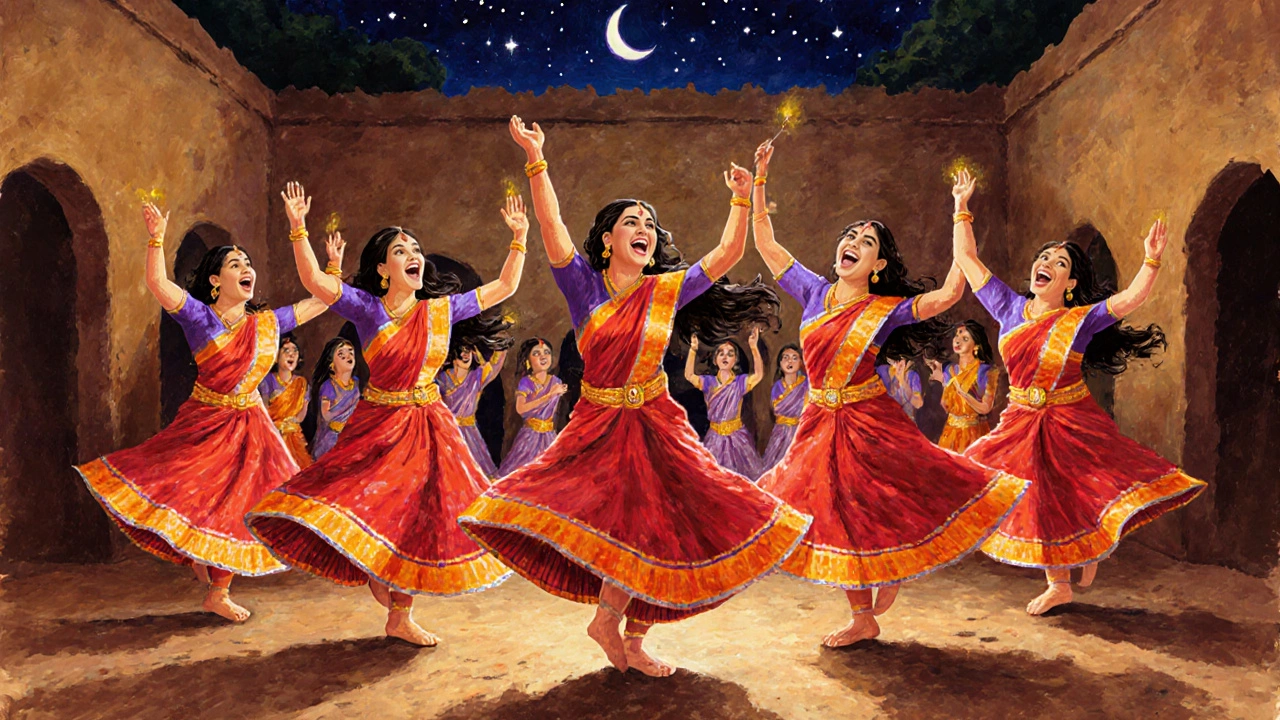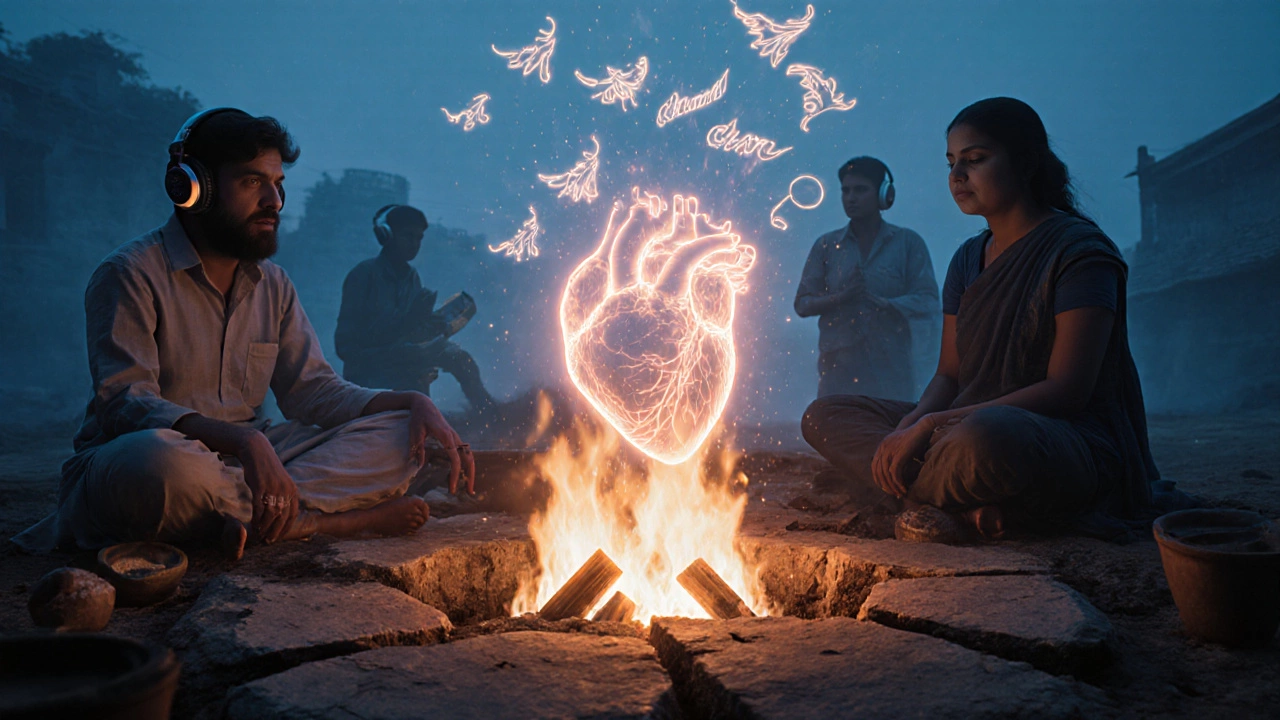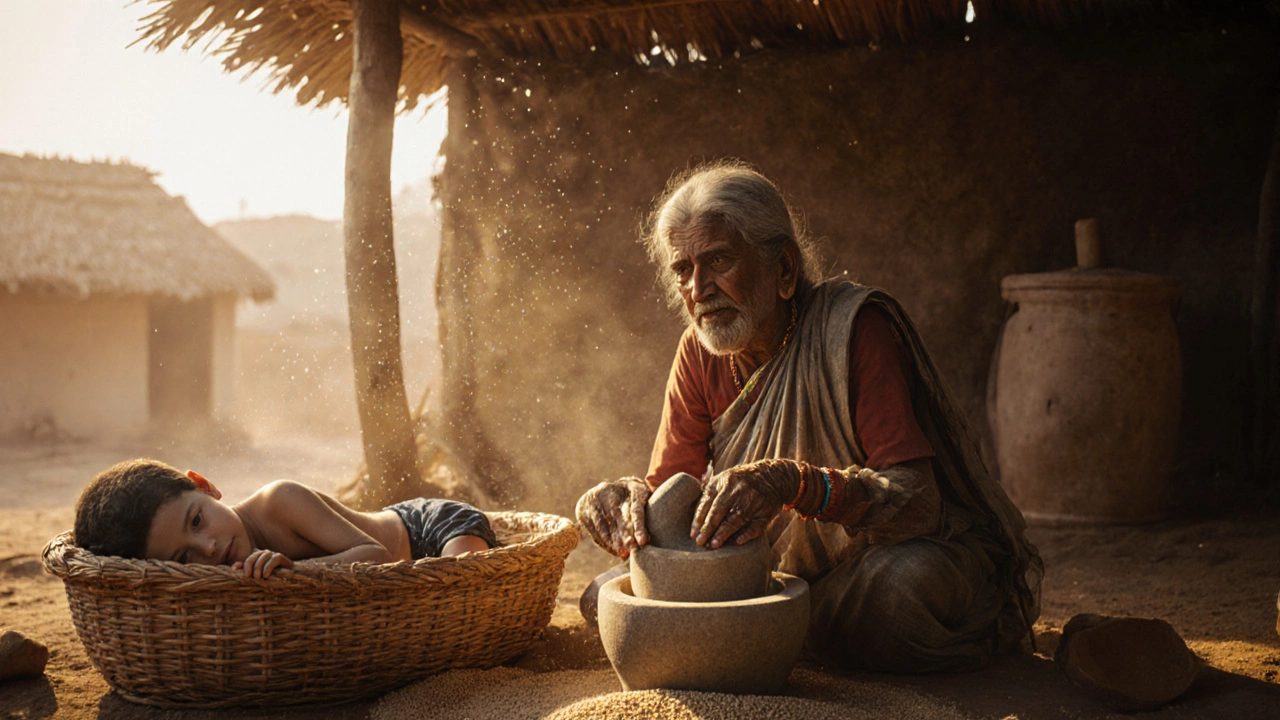Bol Banao Rhythm Generator
Create Your Folk Rhythm
Generate authentic Indian folk vocal patterns using traditional syllables like ta, ka, dhi, and dha. Perfect for understanding Bol Banao!
Adjust to match traditional folk rhythms (40-180 BPM)
Choose how many beats to generate
Your Bol Banao Rhythm
Tempo: 80 BPM
Pattern length: 4 beats
Have you ever heard a folk singer in rural India launch into a burst of syllables that sound like "dha dha gi na ta" or "re re re re re"-with no clear words, no dictionary meaning, but still full of rhythm, emotion, and energy? That’s not a mistake. It’s not gibberish. It’s a centuries-old tradition called bol banao.
What Is Bol Banao?
Bol banao is the Indian folk term for nonsense singing. It’s not random noise. It’s structured vocal play-using rhythmic syllables that mimic percussion, convey mood, or serve as vocal warm-ups. These syllables are drawn from the same sound inventory used in classical and folk percussion: ta, ka, dhi, dha, gi, na, tin, te. But unlike in tabla or pakhawaj training, where these syllables map to specific drum strokes, in folk singing, they become melodic phrases with no literal meaning.
Imagine a mother singing to her child while grinding grain. She doesn’t sing about harvest or rain. She sings "dha dha dha, gi na ta, re re re"-over and over-because the rhythm calms the child, matches her own movement, and keeps her mind in flow. That’s bol banao in action.
Why Do People Sing Nonsense in Folk Music?
There’s a practical reason, and a cultural one.
First, many rural singers in India-especially women-don’t have formal training in notation or lyrics. They learn by ear. Nonsense syllables let them improvise melodies without needing to remember exact words. They can stretch a phrase, repeat a pattern, or shift tempo on the fly, all while keeping the rhythm tight.
Second, these syllables carry emotional weight. A slow "aai aai" can sound mournful. A rapid "tiriri tiriri" can feel joyful. In Baul songs from Bengal, singers use "hola hola" to mimic the wind. In Gond tribal chants from Madhya Pradesh, "dhum dhum" echoes the beat of the dholak. The meaning isn’t in the dictionary-it’s in the body, the breath, the heartbeat.
This isn’t unique to India. Think of scat singing in jazz, or the "la la la" in Western lullabies. But in Indian folk traditions, bol banao is woven into daily life-not just performance.
Where Is It Most Common?
Bol banao shows up everywhere, but it’s especially strong in regions where oral traditions are still alive:
- Bengal: In Baul and Bhatiyali songs, singers use "hola hola," "aai aai," and "re re re" to express spiritual longing. The syllables become a bridge between the human voice and the divine.
- Odisha: In Dalkhai and Sambalpuri folk dances, the chorus sings rhythmic nonsense like "dha dha dha, tin tin tin" to keep dancers in sync. The words aren’t needed-the rhythm is the message.
- Maharashtra: Lavani singers use "thak thak thak" to mimic the sound of ankle bells, turning vocalization into percussion.
- Central India (Gond, Bhil tribes): Chants like "dhum dhum," "bhang bhang," or "tak tak tak" are used in healing rituals. The repetition isn’t decorative-it’s medicinal.
- Rajasthan: In Manganiyar and Langha singing, nonsense syllables act as vocal ornaments between verses, like a musical exhale.
Even in modern Indian pop, you’ll hear echoes-think of the "oh oh oh" in A.R. Rahman’s film songs. It’s bol banao, dressed in studio reverb.

How Is It Different From Classical Solfa?
People often confuse bol banao with sargam-the Indian system of solfège: Sa, Re, Ga, Ma, Pa, Dha, Ni. But they’re worlds apart.
Sargam is a scale. It’s precise. It’s taught in gharanas. It’s used to train the ear and build pitch accuracy.
Bol banao is rhythm-first. It’s emotional. It’s born in fields, not classrooms. You won’t find it in a ragamala chart. It doesn’t care if you’re in Raga Bhairavi or Raga Malkauns. It just needs to feel right.
Think of it this way: Sargam is like writing a letter. Bol banao is like humming while you walk.
Is It Just for Women?
No-but it’s mostly women who keep it alive.
In many villages, men are the ones who perform publicly: the dhol players, the storytellers, the classical vocalists. But women are the ones singing while working: fetching water, husking rice, rocking babies. They’re the silent archive of bol banao.
When anthropologists recorded folk singers in Chhattisgarh in the 1980s, they found that 78% of the nonsense phrases were sung by women. Not because men couldn’t do it-but because it was part of their daily rhythm, not their public role.
Today, younger women in cities are rediscovering these sounds. Artists like Anupama Bhagwat and Shilpa Rao incorporate bol banao into contemporary work-not as a gimmick, but as a living thread.

Why Is It Disappearing?
Modern life is killing bol banao-not because people don’t like it, but because they don’t have time for it.
When women move from villages to cities, they stop grinding grain by hand. They stop rocking babies while singing. They start using headphones and playlists. The rhythm of daily life changes. The songs fade.
Also, schools don’t teach it. Music academies focus on ragas and notation. Nonsense singing? That’s not "real music," they say. But it’s the music that kept generations sane, connected, and rhythmic.
Some NGOs and cultural groups are trying to record these sounds before they vanish. The National Folklore Support Centre in Chennai has archived over 300 variations of bol banao from 12 states. But without young people learning them in homes, not studios, they’ll remain museum pieces.
Can You Learn It?
Yes-but not from a book.
Start by listening. Find recordings of Baul singers, Gond chants, or Odia Dalkhai chorus. Don’t try to copy the sounds. Try to feel them.
Then, try this: Walk around your house. Tap your foot. Hum something simple. Now replace the hum with syllables: "ta ka dhi na" or "re re re". Don’t think about pitch. Think about pulse. Let your body lead.
That’s bol banao. It’s not about being perfect. It’s about being present.
Next time you hear someone singing nonsense in a folk song, don’t think "what are they saying?" Think: "what are they feeling?"
Is nonsense singing the same as scat singing in jazz?
They’re similar in that both use improvised syllables without words, but they come from different roots. Jazz scat singing evolved from instrumental improvisation and focuses on pitch, harmony, and swing. Indian bol banao comes from daily rhythm and percussion-its power lies in pulse, not harmony. Scat is about solo expression; bol banao is often communal and tied to movement.
Are there any famous songs with nonsense singing?
Yes. The Baul song "Holo Holo" by Lalon Fakir uses repeated nonsense syllables to express spiritual unity. In modern times, the song "Chaiyya Chaiyya" from the film Dil Se features rhythmic vocalizations that echo bol banao traditions. Even in folk recordings from Odisha, you’ll find tracks where the entire chorus sings "dha dha dha" for minutes, with no lyrics at all.
Do children learn bol banao naturally?
In villages, yes. Children hear their mothers and grandmothers singing while working and naturally mimic the sounds. It’s like learning to walk-no one teaches it formally, but everyone does it. In cities, children rarely hear it unless their family preserves the tradition. That’s why it’s fading.
Can bol banao be written down?
It can be transcribed, but it loses something. The real power is in the breath, the timing, the slight delay between syllables. A notation might show "ta ka dhi na," but it can’t capture how a singer lets the "na" fade into silence, or how the "dhi" is pushed with a sigh. That’s why recordings are more valuable than sheet music.
Is bol banao used in religious rituals?
Absolutely. In Gond and Bhil tribal ceremonies, repetitive nonsense chants are used to enter trance states. In Sufi qawwalis, some singers use syllables like "ha ha ha" or "wa wa wa" to express divine ecstasy. These aren’t lyrics-they’re sonic tools to shift consciousness.
